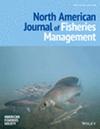蓝头吸盘幼虫密度增加可降低临界热最大值
IF 1.4
4区 农林科学
Q3 FISHERIES
引用次数: 0
摘要
蓝头吸盘虫(Catostomus disbolus)所使用的溪流经历了高、低极端和极端变化率的可变水温。急性和慢性实验室温度测试已用于制定保护性热标准,但这些方法不允许测试温度与其他应激源相互作用的致命性。例如,鱼类密度和温度的相互作用很可能发生在低流量时期,在停滞池中有高密度的鱼类搁浅;但标准的热测试只包括一条鱼。我们研究了代表田间温度(8°C和18°C)的两种驯化温度对孵化成功率和幼虫存活率的影响,以及临界热最大值(CTMax)和最低温度(CTMin)。然后,我们研究了密度(n = 1, n = 10, n = 25鱼/ 2 L)和温度的相互作用如何影响CTMax或CTMin。结果表明,在18℃条件下,蓝头吸盘幼虫的孵化成功率和存活率最高,18℃温度范围为7.2±1.6℃~ 32.1±2.4℃。然而,当幼虫密度较高(n = 25 / 2 L)时,温度上限显著降低5.9°C。我们的研究结果表明,较高的鱼类密度会对鱼类对温度升高的耐受性产生负面影响。因此,在制定保护温度标准时,应考虑密度和温度的相互作用。本文章由计算机程序翻译,如有差异,请以英文原文为准。
Increased density of Bluehead Sucker larvae decreases critical thermal maximum
Streams used by Bluehead Suckers Catostomus discobolus experience variable water temperatures of high and low extremes and extreme rates of change. Acute and chronic laboratory temperature tests have been used to develop protective thermal criteria, but these methods do not allow for testing the lethality of temperature interactions with other stressors. For instance, fish density and temperature interactions are likely to occur during low‐flow periods with high densities of fish stranded in a stagnant pool; but standard thermal tests only included one fish.We examined the effect of two acclimation temperatures that represent field temperatures (8°C and 18°C) on hatch success and larval survival, and the critical thermal maximum (CTMax) and minimum temperatures (CTMin). We then investigated how the interaction of density (n = 1, n = 10, n = 25 fish per 2 L) and temperature influence CTMax or CTMin.We found maximum egg hatch success and larval survival at 18°C and the temperature range for Bluehead Sucker larvae at 18°C was 7.2 ± 1.6°C to 32.1 ± 2.4°C. However, when the density of the larvae was high (n = 25 per 2 L) the upper thermal limit significantly decreased by 5.9°C.Our results indicate higher fish densities negatively affect the tolerance of the fish to increased temperature. Thus, density and temperature interactions should be considered when developing protective temperature criteria.
求助全文
通过发布文献求助,成功后即可免费获取论文全文。
去求助
来源期刊
CiteScore
2.60
自引率
18.20%
发文量
118
审稿时长
2 months
期刊介绍:
The North American Journal of Fisheries Management promotes communication among fishery managers with an emphasis on North America, and addresses the maintenance, enhancement, and allocation of fisheries resources. It chronicles the development of practical monitoring and management programs for finfish and exploitable shellfish in marine and freshwater environments.
Contributions relate to the management of fish populations, habitats, and users to protect and enhance fish and fishery resources for societal benefits. Case histories of successes, failures, and effects of fisheries programs help convey practical management experience to others.

 求助内容:
求助内容: 应助结果提醒方式:
应助结果提醒方式:


